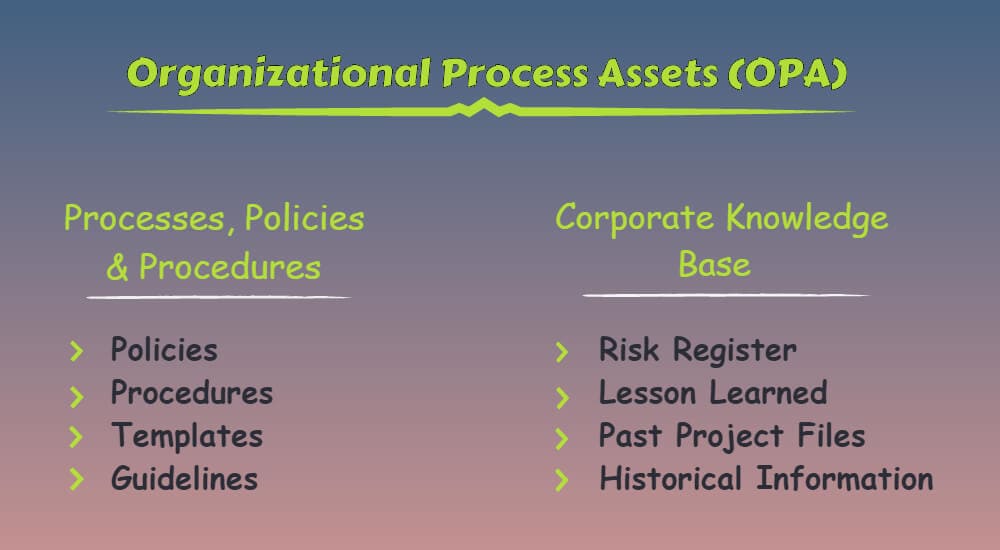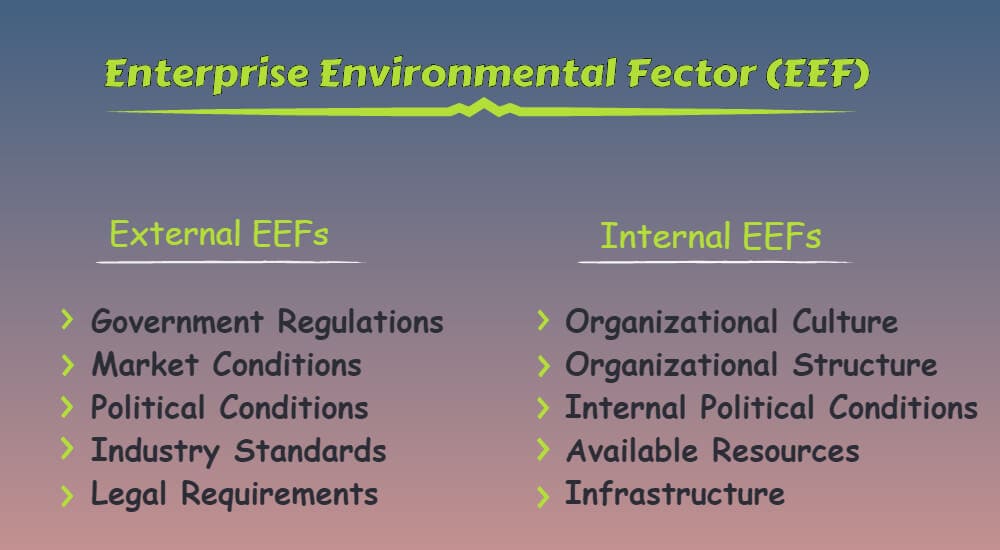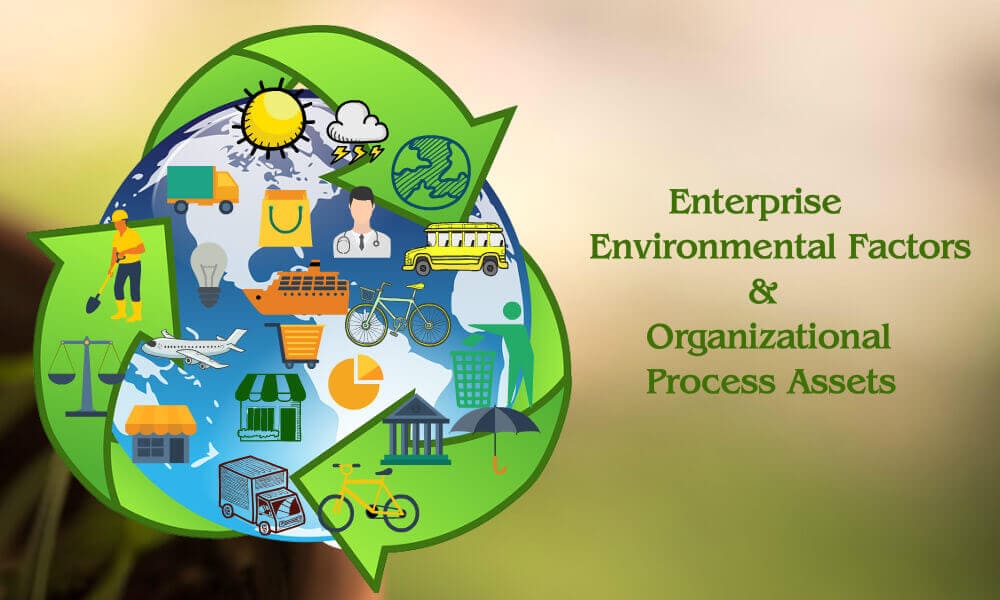Organizational Process Assets (OPA) and Enterprise Environmental Factors (EEF) are key concepts in project management. The PMBOK Guide defines them as “influences” because they impact a project’s processes and outcomes. These elements are both inputs and outputs in many project management processes.
OPA and EEF are extensively used throughout project management to guide planning and execution. While the PMBOK Guide provides a detailed explanation of these concepts, some aspects can still confuse learners.
I will clarify both topics in this blog post and shed light on their practical applications.
We will discuss Organizational Process Assets and Enterprise Environmental Factors in depth, focusing on how they influence projects.
Let us look at Organizational Process Assets and their role in project management.
Organizational Process Assets (OPA)

The PMBOK Guide defines Organizational Process Assets (OPA) as “plans, processes, policies, procedures, and knowledge bases that are specific to and used by the performing organization.”
These resources accumulate over time and help organizations manage projects more efficiently by providing valuable insights and standardized tools.
OPA includes various elements that support project management, such as lessons learned, historical records, policies, procedures, templates, and knowledge repositories. These resources ensure consistency and improve decision-making in project execution.
While templates can be adjusted to meet specific project needs, policies, processes, and procedures cannot be modified, as they are developed and maintained by higher authorities like the Project Management Office (PMO).
Examples of OPA
Examples of OPA include:
- Risk registers
- Stakeholder registers
- Checklists
- Project management plans
- Issue logs
- Change control procedures
- Performance reports
- Quality checklists
- Training materials
- Communication guidelines
Using OPA effectively, project managers can leverage organizational knowledge to enhance project outcomes.
Types of OPA
OPA can be divided into two categories:
- Processes, policies, and procedures
- Organizational knowledge bases
Some examples of processes, policies, and procedures are templates for any plans, documents, procedures to carry out work, or any guidelines you have developed.
You can update or add to an organizational knowledge base anytime you wish, and you are encouraged to do this so future projects can benefit from your experience.
Some examples of organizational knowledge bases are lessons learned, old project files, financial databases, etc.
Enterprise Environmental Factors (EEF)

The PMBOK Guide defines Enterprise Environmental Factors (EEF) as “conditions, not under the immediate control of the team, that influence, constrain, or direct the project, program, or portfolio.”
These factors create the environment in which a project operates. They can have either a positive or negative impact on the project but are typically seen as constraints because they limit options for planning and execution.
EEFs are beyond the project team’s control, making it essential for project managers to understand and adapt to them. Their influence is particularly significant during planning, as they shape decisions and strategies. Ignoring EEF, such as laws or regulations, can lead to severe consequences for the project’s success.
Examples of EEF
Examples of EEF include:
- Legal and regulatory requirements
- Organizational culture and structure
- Political environment
- Industry standards
- Market conditions
- Availability of human resources
- Work authorization systems
- Infrastructure and technology
Project managers can anticipate potential challenges and minimize disruptions by considering EEF early in the planning phase.
Types of EEF
EEF can be divided into two categories: Internal EEF and External EEF.
Internal EEF is imposed by the organization on your project. Some examples of internal EEF are resource availability, capability, PMIS, organizational culture, organizational structure, and code of conduct.
External EEFs are outside factors that affect the organization and your project. Some examples of external EEFs are political conditions, marketplace conditions, governmental regulations, and commercial databases.
OPA Vs EEF
- EEF is not under the project management team’s control, and the team must abide by it. OPA is under their control but is not mandatory to follow.
- All project management processes are affected by EEF, but they do not change EEF. The processes use OPA, which can be modified and updated when required.
- EEF imposes limitations on the project, and sometimes, managing them is difficult. OPA helps you run the project, and they rarely impose any restrictions.
- It is challenging to change any EEF, and most of the time, you have to follow it. On the other hand, you can modify OPA as you wish. OPAs are always updated as you continue to gain new knowledge and learn new lessons.
- EEF can be internal or external to an organization, while OPAs are always internal.
Why are PMIS and Work Authorization Systems EEF, not OPA?
I have been asked countless times why a Project Management Information System (PMIS) is an EEF, not an OPA, as it is bought, customized, and used by the organization.
Please note that although your organization uses PMIS, you cannot change it. You must align your processes according to the system and use it for your benefit. The reports and documents generated by PMIS are OPA, but the PMIS is an EEF.
Likewise, Work Authorization Systems are also EEF, as they are defined at an organizational level, and you do not have any control over them. You have to follow them. The Work Authorization System is a subsystem of PMIS.
The Importance of OPA and EEF in Project Management
Organizational Process Assets (OPA) and Enterprise Environmental Factors (EEF) are essential elements in project management as they significantly influence how projects are planned, executed, and controlled.
Organizational Process Assets (OPA)
OPA provides a wealth of knowledge and resources that enhance project success. These assets include historical records, templates, policies, procedures, and lessons learned. They offer a structured approach to project planning and execution, ensuring project consistency.
For example:
- Templates streamline documentation.
- Lessons learned help avoid past mistakes and improve decision-making.
- Procedures and standards ensure compliance with organizational practices.
By leveraging OPA, project teams can optimize efficiency, maintain quality, and reduce risks.
Enterprise Environmental Factors (EEF)
EEF shapes the environment in which the project operates. These factors include external conditions like legal requirements, market conditions, and industry standards, as well as internal conditions like organizational culture and available resources.
- EEF imposes constraints but also provides opportunities for strategic alignment.
- Understanding EEF helps project managers adapt plans and manage risks effectively.
By considering EEF, project teams can navigate challenges and align project outcomes with external and organizational realities.
OPA and EEF form the backbone of effective project management by offering guidance, ensuring compliance, and fostering adaptability.
Discrepancies in the PMBOK Guide
I have received many emails from PMP aspirants regarding discrepancies in the PMBOK Guide about OPA and EEF.
Some elements appear in OPA as well as in EEF, which led professionals to think that the PMBOK Guide has some discrepancies regarding the OPA and EEF. Although there can be discrepancies, I believe this is not the case. The project management environment is dynamic, and there are many grey areas; therefore, we have to look at each discrepancy on a case-by-case basis.
For example, any organizational policy or procedure can be an EEF, but it will be an OPA if you create a policy or procedure specific to your project.
Summary
OPA and EEF are two forms of influence on the project. Although EEF can sometimes be a constraint, they are for the greater good of the project, organization, and community. For example, regulations regarding pollution or noise control are constraints imposed on your project, but they are for the greater good.
When managing your project, you must have a firm understanding of these factors, as they provide you with the environment and necessary knowledge base. You have to follow EEF, use OPA, and contribute to the knowledge base as well so future generations can benefit from it.

Amazing… I have almost completed my preparation for PMP exam, looking for a good stimulator, is there anything, which will be good with economical price.
You can try whizlabs simulator. It is the cheapest one.
Excellent! Well-written article!
Thank you Kalsum.
Dear Fahad,
Thank you for the great article. Could you please explain Internal EEF will also not come under PMT. ? I have read some books External EEF are not under control of PMT. Kindly provide more information if possible.
Many thanks.
Kind regards,
booraj
Can a project management team change the law or a government regulation?
No, they cannot. Therefore, external EEFs are not under control of project management team.
Thank you!.. after reading the article, I can clearly understand the difference between OPAs and EEFs
You are welcome Maria.
It Is a really good article, many thanks Fahad.
Good article showing in depth knowledge of the author. Very informative. Thanks
Clear and crisp artical. Thanks.
very good
thanks
Excellent, well explained
I must say after reading this i now understand.
You have done a great job by breaking this down in a very simple form.
Thank You.